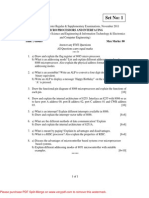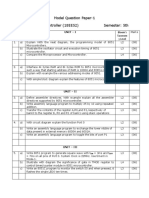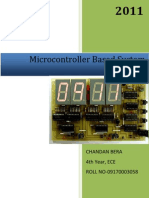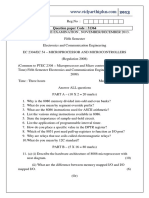0 ratings0% found this document useful (0 votes)
40 viewsAssignment2 PDF
This document contains instructions for 5 programming questions involving interfacing various hardware components like EPROM chips, 7-segment LED displays, timers, relays, and washing machines with 8086 and 8051 microcontrollers. Students are asked to provide circuit diagrams using logic gates for address decoding and write programs to control and read states of the interfaces. The questions cover topics like memory mapping, I/O port programming, timers and counters, digital input/output, and voltage monitoring.
Uploaded by
sanjayCopyright
© © All Rights Reserved
Available Formats
Download as PDF, TXT or read online on Scribd
0 ratings0% found this document useful (0 votes)
40 viewsAssignment2 PDF
This document contains instructions for 5 programming questions involving interfacing various hardware components like EPROM chips, 7-segment LED displays, timers, relays, and washing machines with 8086 and 8051 microcontrollers. Students are asked to provide circuit diagrams using logic gates for address decoding and write programs to control and read states of the interfaces. The questions cover topics like memory mapping, I/O port programming, timers and counters, digital input/output, and voltage monitoring.
Uploaded by
sanjayCopyright
© © All Rights Reserved
Available Formats
Download as PDF, TXT or read online on Scribd
You are on page 1/ 1
Assignment #02
System design and Programming Questions: Make sure your circuit
interface diagrams are drawn neatly. Use an open source tool like
mcu8051ide or edsim51di to write and execute the 8051 based
programs. Each question carries 6 marks.
Q1. Show the complete interface of two 16KB EPROM chips with 8086, such that the
memory address space assigned to EPROM chips is F8000H to FFFFFH. Use basic
logic gates only for address decoding purpose.
Q2. Interface a seven segment LED connected in common cathode configuration,
with 8086 operating in minimum mode. The seven segment LED is interfaced at an
address of 7FH. Use basic logic gates for address decoding. Write the instructions
needed to display a number 5 on the LED, using fixed port and variable port
addressing scheme.
Q3. Interface 8253 timer having the base address of 0810H with 8086. The 8086 is
operating at a frequency of 5 MHz. Use basic logic gates for address decoding.
Program counter 0 to (i) generate high output signal at its OUT pin after one
millisecond, (ii) read the content of counter using counter latch command and read
back command.
Q4. For 8051, configure port P1 to read switches at P1.0 and P1.1. If P1.0 is high,
turn on a relay connected to P2.5 by sending a logic high output. If P1.0 is low, clear
P2.5. If the status of P1.1 is high, turn off the relay connected to P2.6 by sending a
logic low output. If P1.1 is low, set P2.6 to a high state.
Q5. A washing machine is designed for a voltage range of 180-240 volts. If the
voltage is above 240V or below 180V, the washing machine will shut down by
turning off a relay connected to port P1.0. Assume that the voltage can be read at
Port 0 in the range of 0-255V. Write a program for 8051 to implement this operation.
You might also like
- 11 Microprocessors And Microcontrollers-Apr 2015No ratings yet11 Microprocessors And Microcontrollers-Apr 20154 pages
- ET7102-Microcontroller Based System Design QB PDF100% (1)ET7102-Microcontroller Based System Design QB PDF10 pages
- Ece IV Microcontrollers (10es42) AssignmentNo ratings yetEce IV Microcontrollers (10es42) Assignment3 pages
- Model Question Paper-1 Subject: Microcontroller (18EE52) Semester: 5thNo ratings yetModel Question Paper-1 Subject: Microcontroller (18EE52) Semester: 5th4 pages
- Model Question Paper-1 Subject: Microcontroller (18EE52) Semester: 5thNo ratings yetModel Question Paper-1 Subject: Microcontroller (18EE52) Semester: 5th4 pages
- Microprocessors and Interfacingjntumodelpaperwww Studentyogi Com 100113225356 Phpapp01No ratings yetMicroprocessors and Interfacingjntumodelpaperwww Studentyogi Com 100113225356 Phpapp018 pages
- Embedded Controller Solved Question PapersNo ratings yetEmbedded Controller Solved Question Papers55 pages
- Radha Govind Engineering College, MeerutNo ratings yetRadha Govind Engineering College, Meerut19 pages
- Microprocessorsand Applications Anna University Question by FresherscampusNo ratings yetMicroprocessorsand Applications Anna University Question by Fresherscampus2 pages
- r05320202 Microprocessors and Micro ControllersNo ratings yetr05320202 Microprocessors and Micro Controllers5 pages
- CSECEEEEINSTR F241 PROGRAMMING & Â - 1 PDFNo ratings yetCSECEEEEINSTR F241 PROGRAMMING & Â - 1 PDF7 pages
- RR320202-MICROPROCESSORS-AND-INTERFACING May2008No ratings yetRR320202-MICROPROCESSORS-AND-INTERFACING May20087 pages
- B.E. Degree Examinations: Nov / Dec 2010 Fifth Semester Mechatronics EngineeringNo ratings yetB.E. Degree Examinations: Nov / Dec 2010 Fifth Semester Mechatronics Engineering2 pages
- Unit I - Introduction To Embedded Systems: Assignment1No ratings yetUnit I - Introduction To Embedded Systems: Assignment112 pages
- Bharathidasan Engineering College NATTRAMPALLI - 635 854.: B.E., EEE - 3 YearNo ratings yetBharathidasan Engineering College NATTRAMPALLI - 635 854.: B.E., EEE - 3 Year2 pages
- 245117-23IT1302 – Microprocessor and Microcontroller DesignNo ratings yet245117-23IT1302 – Microprocessor and Microcontroller Design3 pages
- AMP Question Bank Unit Wise Dr. P.R. Deshmukh PDFNo ratings yetAMP Question Bank Unit Wise Dr. P.R. Deshmukh PDF3 pages
- DMC6312 - Internet of Things LaboratoryNo ratings yetDMC6312 - Internet of Things Laboratory47 pages
- Answer All Questions. Figures at The Right Hand Margin Indicate Marks. All Parts of A Question Should Be Answered at One PlaceNo ratings yetAnswer All Questions. Figures at The Right Hand Margin Indicate Marks. All Parts of A Question Should Be Answered at One Place2 pages



























































